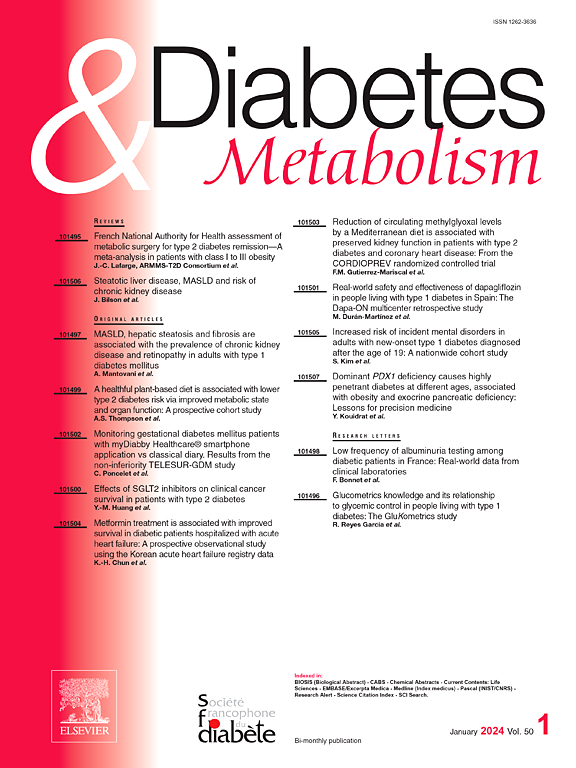铁蛋白水平升高与肾移植后糖尿病的发生有关:一项前瞻性队列研究
IF 4.7
2区 医学
Q1 ENDOCRINOLOGY & METABOLISM
引用次数: 0
摘要
目的:已知铁在葡萄糖稳态中起作用,而糖尿病在铁超载患者中非常普遍。在这里,我们研究了铁蛋白和hepcidin(作为铁状态的参数)是否与肾移植受者移植后糖尿病的发展有关,已知肾移植受者中约10%具有高铁状态。方法:对来自荷兰格罗宁根大学医学中心的plantlines胰岛素抵抗和炎症生物库和队列研究的前瞻性数据进行评估,包括移植后10 ~ 10年的稳定成人肾移植受者。通过多变量Cox回归模型分析铁蛋白和hepcidin水平(作为铁状态的标志)与移植后糖尿病发病率之间的关系,然后探索铁蛋白水平与移植后糖尿病风险相关的潜在临床临界值。结果:纳入的443例肾移植受者(年龄50±12岁,44%为女性,移植后中位6.1[3.0 - 12.1]年)中,65例肾移植受者(15%)在中位随访9.6[6.3 - 10.2]年期间出现移植后糖尿病。与hepcidin水平相反,铁蛋白水平与移植后糖尿病的发生显著相关,独立于潜在混杂因素的完全调整(HR / 50µg/l, 1.08;95% ci 1.02 - 1.14)。当分析铁蛋白水平的特定临床临界值时,与铁蛋白< 100µg/l的肾移植受者相比,铁蛋白水平为500µg/l (n=40)的肾移植受者发生移植后糖尿病的风险高出两倍以上(HR, 2.81;95% ci 1.04 - 7.55)。结论:铁蛋白水平升高与肾移植受者移植后糖尿病风险升高独立相关。特别是,随着时间的推移,铁蛋白水平达到50µg/l的肾移植受者似乎容易发生移植后糖尿病。本文章由计算机程序翻译,如有差异,请以英文原文为准。
Increased ferritin levels are associated with incident diabetes after kidney transplantation: A prospective cohort study
Aim
Iron is known to play a role in glucose homeostasis, and diabetes is highly prevalent in patients with iron overload. Here, we investigated whether ferritin and hepcidin (as parameters of iron status) are associated with the development of post-transplant diabetes in kidney transplant recipients, a population in which around 10 % is known to have high iron status.
Methods
Prospective data from the TransplantLines Insulin Resistance and Inflammation Biobank and Cohort Study from the University Medical Center Groningen, the Netherlands were evaluated, involving stable adult kidney transplant recipients > 1 year after transplantation. Associations between ferritin and hepcidin levels, as markers of iron status, and incident post-transplant diabetes were analyzed by multivariable Cox regression models, followed by the exploration of potential clinical cut-offs of ferritin levels related to the risk of post-transplant diabetes.
Results
Of the included 443 kidney transplant recipients (age 50 ± 12 years, 44 % women, median 6.1 [3.0 – 12.1] years after transplantation), 65 kidney transplant recipients (15 %) developed post-transplant diabetes during a median follow-up of 9.6 [6.3 – 10.2] years. In contrast to hepcidin levels, ferritin levels were significantly associated with incident post-transplant diabetes, independent of adjustment for potential confounders (HR per 50 µg/l, 1.08; 95 % CI 1.02 – 1.14). When analyzing specific clinical cut-offs of ferritin levels, kidney transplant recipients with a ferritin > 500 µg/l (n=40) had more than twice the risk of developing post-transplant diabetes, compared to kidney transplant recipients with ferritin < 100 µg/l (HR, 2.81; 95 % CI 1.04 – 7.55).
Conclusions
Increased levels of ferritin are independently associated with a higher risk of post-transplant diabetes in kidney transplant recipients. Especially, kidney transplant recipients with ferritin levels > 500 µg/l, seem susceptible to the development of post-transplant diabetes over time.
求助全文
通过发布文献求助,成功后即可免费获取论文全文。
去求助
来源期刊

Diabetes & metabolism
医学-内分泌学与代谢
CiteScore
12.00
自引率
4.20%
发文量
86
审稿时长
13 days
期刊介绍:
A high quality scientific journal with an international readership
Official publication of the SFD, Diabetes & Metabolism, publishes high-quality papers by leading teams, forming a close link between hospital and research units. Diabetes & Metabolism is published in English language and is indexed in all major databases with its impact factor constantly progressing.
Diabetes & Metabolism contains original articles, short reports and comprehensive reviews.
 求助内容:
求助内容: 应助结果提醒方式:
应助结果提醒方式:


